The rapier evolved over some 200 years from the primarily cutting sword of the late 15th and early 16th Centuries into the primarily thrusting sword of the mid to late 17th Century. It may even be surmised that the rapier developed into the smallsword used during the 17th and 18th Centuries.
In order to understand the mechanics of why certain techniques were used in rapier play, it is prudent to study the form and mechanics of the blades themselves.
In the summer of 1999 I was able to go to the Royal Armouries in Leeds England and handle/measure rapiers. The results of this study may be found here. In June of 2001 I travelled to Scotland where I was able to look at pieces from two different collections. For an initial look at a few of the swords (and also to see pictures from an SCA event I attended) click here. I am currently working on the page for the 2001 Scottish trip report on swords we measured. Keep checking here for progress on the report.
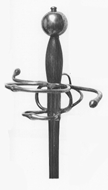 This piece dates from 1550-1560.
The overall length is 48 1/4" with a blade length of 42 3/4". The
width is 1 1/8". The sword weighs 2 lb. 11 oz. The pommel is large
and spherical. The quillons and guard are round in cross-section.
The ricasso on the blade is stout and ribbed. The blade itself is
diamond in cross-section with fluting.
This piece dates from 1550-1560.
The overall length is 48 1/4" with a blade length of 42 3/4". The
width is 1 1/8". The sword weighs 2 lb. 11 oz. The pommel is large
and spherical. The quillons and guard are round in cross-section.
The ricasso on the blade is stout and ribbed. The blade itself is
diamond in cross-section with fluting.
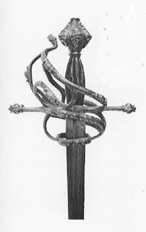 This sword dates from the late
16th Century. The overall length of the piece is 45 1/4". The blade is
39 1/2" long with a width of 1 1/4". The weight of the weapon is 3 lb.
2 oz. The pommel is diamond shaped and chiselled with lions' heads. The
original grip is flutted wood. The guard itself is also chiselled and
is symetrical front to back. The blade is a hexogonal and is double
edged.
This sword dates from the late
16th Century. The overall length of the piece is 45 1/4". The blade is
39 1/2" long with a width of 1 1/4". The weight of the weapon is 3 lb.
2 oz. The pommel is diamond shaped and chiselled with lions' heads. The
original grip is flutted wood. The guard itself is also chiselled and
is symetrical front to back. The blade is a hexogonal and is double
edged.
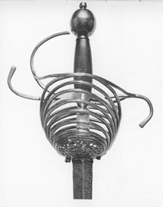 This sword dates from approximately
1620 and is either Spanish or Italian. The overal length is 55 3/4" with
a blade length of 50" and a width of 1 1/8". The guard is semetrical with
stylized shells near the ricasso. The blade itself is diamond cross-section.
This sword dates from approximately
1620 and is either Spanish or Italian. The overal length is 55 3/4" with
a blade length of 50" and a width of 1 1/8". The guard is semetrical with
stylized shells near the ricasso. The blade itself is diamond cross-section.
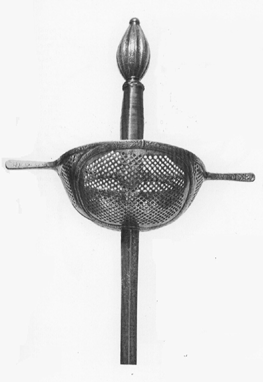 This sword dates from approximately
1630 and is believed to be English. The overall length is 50 1/4" with a
blade length of 43" and width of 3/4". The sword weighs 2 lb. 4 oz. The
hilt on this piece is very large; larger than most of its type. The pommel
is about 3" long and 1 3/8" wide maximally. The grip is octogonal with
wire wrap and turk's heads. The quillons are flattened and florally
engrasved as is the cup. The cup itself is pierced with squares and circles.
This sword dates from approximately
1630 and is believed to be English. The overall length is 50 1/4" with a
blade length of 43" and width of 3/4". The sword weighs 2 lb. 4 oz. The
hilt on this piece is very large; larger than most of its type. The pommel
is about 3" long and 1 3/8" wide maximally. The grip is octogonal with
wire wrap and turk's heads. The quillons are flattened and florally
engrasved as is the cup. The cup itself is pierced with squares and circles.
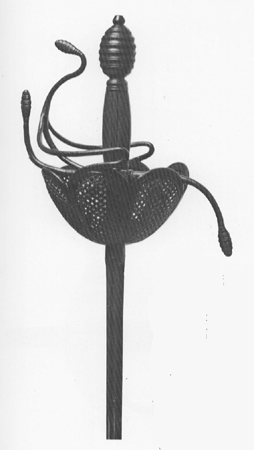 This sword dates from approximately
1630 and is believed to be Italian. The overall length is 51 3/4" with a
blade length of 46" and width of 3/4". The sword weighs 2 lb. 12 oz. The
hilt on this piece is decorated with a trellis design. The blade is
hexogonal in section.
This sword dates from approximately
1630 and is believed to be Italian. The overall length is 51 3/4" with a
blade length of 46" and width of 3/4". The sword weighs 2 lb. 12 oz. The
hilt on this piece is decorated with a trellis design. The blade is
hexogonal in section.
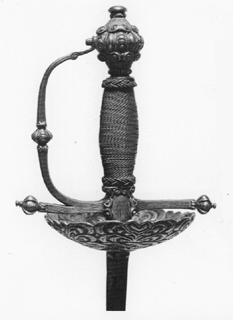 This sword dates from approximately
1630 and is believed to be English. The overall length is 51 1/4" with a
blade length of 45 1/4" and width of 3/4". The sword weighs 1 lb. 12 oz.
The hilt on this piece is a shallow cup. The guard and pommel are
chiselled and engraved. The blade is diamond in section widening out at
the tip for the "stramazone" or slashing cut.
This sword dates from approximately
1630 and is believed to be English. The overall length is 51 1/4" with a
blade length of 45 1/4" and width of 3/4". The sword weighs 1 lb. 12 oz.
The hilt on this piece is a shallow cup. The guard and pommel are
chiselled and engraved. The blade is diamond in section widening out at
the tip for the "stramazone" or slashing cut.
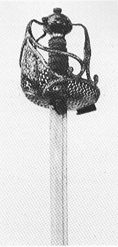 This backsword dates from 1640 and is
thought to have belonged to Oliver Cromwell. The basket hilt is of a
mortuary type. The blade is straight with a single edge and a single
fuller near the spine. The overall length of the sword is 38.2" with a
blade length of 31.9". The weapon weighs 2 lb. 6 oz. The sword was
included to show some differences and similarities between military and
civilian swords.
This backsword dates from 1640 and is
thought to have belonged to Oliver Cromwell. The basket hilt is of a
mortuary type. The blade is straight with a single edge and a single
fuller near the spine. The overall length of the sword is 38.2" with a
blade length of 31.9". The weapon weighs 2 lb. 6 oz. The sword was
included to show some differences and similarities between military and
civilian swords.
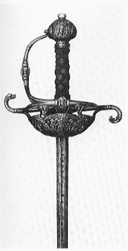 This rapier dates from 1634-1650. The
hilt is british and the blade possibly North Italian. The overall length
of the sword is 46 1/2" with a blade length of 38.7". The weapon weighs 2
lb. 4 oz. The guard is saucer shaped and is heavilly chiselled. It
appears that the heads of Charles I and his Queen are in relief on the
guard. The blade is diamond section.
This rapier dates from 1634-1650. The
hilt is british and the blade possibly North Italian. The overall length
of the sword is 46 1/2" with a blade length of 38.7". The weapon weighs 2
lb. 4 oz. The guard is saucer shaped and is heavilly chiselled. It
appears that the heads of Charles I and his Queen are in relief on the
guard. The blade is diamond section.
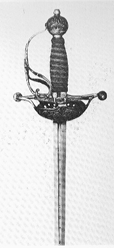 This rapier dates from 1640-1655. The
hilt scabbard are British and the blade possibly German. The overall
length of the sword is 47.2" with a blade length of 39.5". The weapon
weighs 2 lb. The shell hilt is late in period for this type of sword. The
hilt is chiselled with foliage in relief. It is also blued and fire-gilt.
The blade is a flattened hexogonal section.
This rapier dates from 1640-1655. The
hilt scabbard are British and the blade possibly German. The overall
length of the sword is 47.2" with a blade length of 39.5". The weapon
weighs 2 lb. The shell hilt is late in period for this type of sword. The
hilt is chiselled with foliage in relief. It is also blued and fire-gilt.
The blade is a flattened hexogonal section.
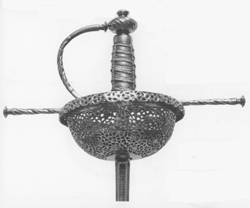 This sword dates from approximately
1660 and is Spanish. The overall length is 49 1/4" with a blade length of
44 1/2" and width of 5/8". The sword weighs 2 lb. The hilt on this piece
is a pierced cup. The grip is bound with silver wire and is made of four
vertical steel bands. The blade is diamond in section.
This sword dates from approximately
1660 and is Spanish. The overall length is 49 1/4" with a blade length of
44 1/2" and width of 5/8". The sword weighs 2 lb. The hilt on this piece
is a pierced cup. The grip is bound with silver wire and is made of four
vertical steel bands. The blade is diamond in section.
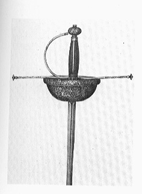 This sword dates from approximately
1660-1670 and is Spanish. The overall length is 50" with a blade length
of 42 1/2". The sword weighs 2 lb 2 oz. The hilt on this piece is a
pierced cup. The edge of the hilt is turned out to form a trap for the
point of the opponent's blade. The wooden grip is bound with copper wire
and has steel ferrules. The blade is flattened hexogonal in section with a
fuller in the forte.
This sword dates from approximately
1660-1670 and is Spanish. The overall length is 50" with a blade length
of 42 1/2". The sword weighs 2 lb 2 oz. The hilt on this piece is a
pierced cup. The edge of the hilt is turned out to form a trap for the
point of the opponent's blade. The wooden grip is bound with copper wire
and has steel ferrules. The blade is flattened hexogonal in section with a
fuller in the forte.
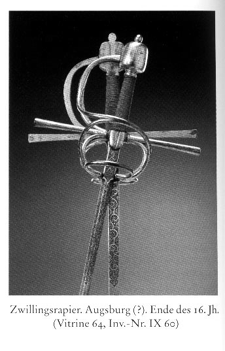 This set of rapiers is in a Museum
in Dresden. The set is from the late 1600's and is
possibly from Augsburg.
This set of rapiers is in a Museum
in Dresden. The set is from the late 1600's and is
possibly from Augsburg.